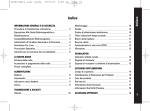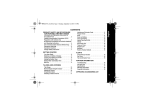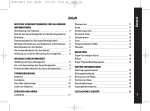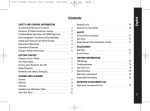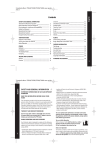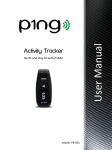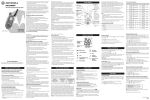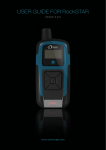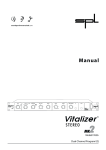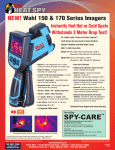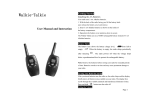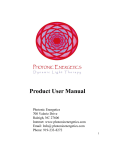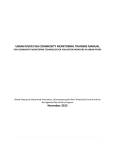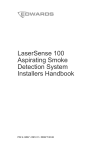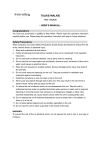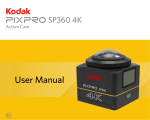Download Contents
Transcript
SAFETY AND GENERAL INFORMATION Transmit And Receive Procedure Exposure To Radio Frequency Energy Portable Radio Operation And EME Exposure Electromagnetic Interference/Compatibility Safety And General Use While Driving Operational Warnings Operational Cautions Charger Safety Instructions 2 2 2 3 4 4 5 5 GETTING STARTED Your New Radio Batteries and Battery Charging Installation of Batteries The Battery Meter and Battery Alert Battery Life Charging Desk Stand Turning Your Radio On And Off Radio Etiquette 7 7 7 8 8 8 9 9 TALKING AND LISTENING Volume Monitor Channel 9 9 9 Interference Eliminator Code Time-Out Timer Keypad Lock Hands Free Use (VOX) 9 10 10 10 ALERTS Channel Busy Indicator Call Tone Roger Beep (Talk Confirmation Tone) 11 11 11 ACCESSORIES Belt Clip Front Covers 11 11 FURTHER INFORMATION Talk Range Troubleshooting Use And Care Specifications Warranty Information Copyright Information 12 13 14 15 15 15 APPROVED ACCESSORIES LIST Approved Accessories List 17 English Contents 1 English SAFETY AND GENERAL INFORMATION IMPORTANT INFORMATION ON SAFE AND EFFICIENT OPERATION READ THIS INFORMATION BEFORE USING YOUR RADIO The information provided in this document supersedes the general safety information contained in user guides published prior to July 2000. This device complies with Part 15 of the FCC Rules. Operation is subject to the following two conditions: (1) this device may not cause harmful interference, and (2) this device must accept any interference received, including interference that may cause undesired operation. TRANSMIT AND RECEIVE PROCEDURE Your two-way radio contains a transmitter and a receiver. To transmit (talk), you must push the M button; to receive (listen), release the M button. EXPOSURE TO RADIO FREQUENCY ENERGY Your Motorola radio is designed to comply with the following national and international standards and guidelines regarding exposure of human beings to radio frequency electromagnetic energy: 2 • United States Federal Communications Commission, Code of Federal Regulations; 47 CFR part 2 sub-part J • American National Standards Institute (ANSI) / Institute of Electrical and Electronic Engineers (IEEE) C95. 1-1992 • Institute of Electrical and Electronic Engineers (IEEE) C95.11999 Edition • International Commission on Non-Ionizing Radiation Protection (ICNIRP) 1998 • Ministry of Health (Canada) Safety Code 6. Limits of Human Exposure to Radiofrequency Electromagnetic Fields in the Frequency Range from 3 kHz to 300 GHz, 1999 • Australian Communications Authority Radiocommunications (Electromagnetic Radiation - Human Exposure) Standard 2001 (applicable to wireless phones only) • ANATEL, Brasil Regulatory Authority, Resolution 256 (April 11, 2001) "additional requirements for SMR, cellular and PCS product certification." To assure optimal radio performance and make sure human exposure to radio frequency electromagnetic energy is within the guidelines set forth in the above standards, always adhere to the following procedures: PORTABLE RADIO OPERATION AND EME EXPOSURE Antenna Care Use only the supplied or an approved replacement antenna. Unauthorized antennas, modifications, or attachments could damage the radio and may violate FCC regulations. DO NOT hold the antenna when the radio is "IN USE". Holding the antenna affects call quality and may cause the radio to operate at a higher power level than needed. Data Operation If applicable, when using any data feature of the radio, with or without an accessory cable, position the radio and its antenna at least one inch (2.5 cm) away from the body. Body-worn Operation To maintain compliance with FCC/Health Canada RF exposure guidelines, if you wear a radio on your body when transmitting, always place the radio in a Motorola supplied or approved clip, holder, holster, case, or body harness for this product. Use of non-Motorola-approved accessories may exceed FCC/Health Canada RF exposure guidelines. If you do not use one of the Motorola-supplied or approved body-worn accessories, and are not using the radio held in the normal use position, ensure the radio and its antenna are at least one inch (2.5 cm) away from your body when transmitting. ELECTROMAGNETIC INTERFERENCE/COMPATIBILITY Note: Nearly every electronic device is susceptible to electromagnetic interference (EMI) if inadequately shielded, designed or otherwise configured for electromagnetic compatibility. To control your exposure and ensure compliance with the general population/uncontrolled environment exposure limits, always adhere to the following procedure: • Transmit no more than 50% of the time. • To transmit (talk), push the M button. • To receive calls, release the M button. Transmitting 50% of the time, or less, is important because the radio generates measurable RF energy exposure only when transmitting (in terms of measuring standards compliance). English Two-way Radio Operation When using your radio as a traditional two-way radio, hold the radio in a vertical position with the microphone one to two inches (2.5 to 5 cm) away from the lips. • Facilities To avoid electromagnetic interference and/or compatibility conflicts, turn off your radio in any facility where posted notices instruct you to do so. Hospitals or health care facilities may be using equipment that is sensitive to external RF energy. • Aircraft When instructed to do so, turn off your radio when on board an aircraft. Any use of a radio must be in accordance with applicable regulations per airline crew instructions. • Devices - Pacemakers The Advanced Medical Technology Association recommends that a minimum separation of 6 inches (15 centimeters) be maintained between a handheld wireless radio and a pacemaker. These recommendations are consistent with the independent research by, and recommendations of, the United States Food and Drug Administration. 3 English Persons with pacemakers should: • ALWAYS keep the radio more than six inches (15 centimeters) from their pacemaker when the radio is turned ON. • Not carry the radio in the breast pocket. • Use the ear opposite the pacemaker to minimize the potential for interference. • Turn the radio OFF immediately if you have any reason to suspect that interference is taking place. - Hearing Aids Some digital wireless radios may interfere with some hearing aids. In the event of such interference, you may want to consult your hearing aid manufacturer to discuss alternatives. - Other Medical Devices If you use any other personal medical device, consult the manufacturer of your device to determine if it is adequately shielded from RF energy. Your physician may be able to assist you in obtaining this information. SAFETY AND GENERAL USE WHILE DRIVING Check the laws and regulations on the use of radio in the area where you drive. Always obey them. When using your radio while driving, please: • Give full attention to driving and to the road. • Use hands-free operation, if available. • Pull off the road and park before making or answering a call if driving conditions so require. 4 OPERATIONAL WARNINGS • For Vehicles With An Air Bag Do not place a portable radio in the area over an air bag or in the air bag deployment area. Air bags inflate with great force. If a portable radio is placed in the air bag deployment area and the air bag inflates, the radio may be propelled with great force and cause serious injury to occupants of the vehicle. • Potentially Explosive Atmospheres Turn off your radio prior to entering any area with a potentially explosive atmosphere, unless it is a radio type especially qualified for use in such areas as "Intrinsically Safe." Do not remove, install, or charge batteries in such areas. Sparks in a potentially explosive atmosphere can cause an explosion or fire resulting in bodily injury or even death. Note: The areas with potentially explosive atmospheres referred to above include fueling areas such as below decks on boats, fuel or chemical transfer or storage facilities, areas where the air contains chemicals or particles, such as grain, dust or metal powders, and any other area where you would normally be advised to turn off your vehicle engine. Areas with potentially explosive atmospheres are often but not always posted. • Blasting Caps And Areas To avoid possible interference with blasting operations, turn off your radio when you are near electrical blasting caps, in a blasting area, or in areas posted: "Turn off two-way radio." Obey all signs and instructions. • Batteries All batteries can cause property damage and/or bodily injury such as burns if a conductive material such as jewelry, keys, or beaded chains touch exposed terminals. The conductive material may complete an electrical circuit (short circuit) and become quite hot. Exercise care in handling any charged battery, particularly when placing it inside a pocket, purse, or other container with metal objects. CHARGER SAFETY INSTRUCTIONS Before using the battery charger, read all instructions and cautionary markings on: 1. the battery 2. the battery charger, and 3. the radio using the battery. Caution: To reduce the risk of injury, only charge the Motorola approved rechargeable battery for this product. Other types of batteries may burst, causing personal injury and damage. SAVE THESE INSTRUCTIONS 1. Do not expose the charger to rain or snow. 2. Do not operate the charger if it has received a sharp blow, or has been dropped or damaged in any way. 3. Do not disassemble the charger if it has received a sharp blow, or has been dropped or damaged in any way. 4. Never alter the AC cord or plug provided with the unit. If the plug will not fit the AC outlet, have proper outlet installed by a qualified electrician. An improper condition can result in a risk of electric shock. 5. To reduce the risk of damage to the cord or plug, pull by the plug rather than the cord when disconnecting the charger from the AC outlet. 6. To reduce the risk of electric shock, unplug the charger from the AC outlet before attempting any maintenance or cleaning. 7. Use of an attachment not recommended or sold by Motorola may result in a risk of fire, electric shock, or personal injury. 8. Make sure the cord is located so that it will not be stepped on, tripped over or subjected to damage or stress. 9. An extension cord should not be used unless absolutely necessary. Use of an improper extension cord could result in a risk of fire and/or electric shock. If an extension cord must be used, make sure: • That the pins on the plug of the extension cord are the same number, size and shape as those on the plug of the charger. • That the extension cord is properly wired and in good electrical condition, and • That the cord size is 18 AWG (1mm2) for lengths up to 100 feet (30 metres) and 16 AWG (1.3mm2) for lengths up to 150 feet (45 metres). 10. The supply cord of this charger cannot be replaced. If the cord is damaged please return to your place of purchase. English OPERATIONAL CAUTIONS • Antennas Do not use any portable radio that has a damaged antenna. If a damaged antenna comes into contact with your skin, a minor burn can result. 5 English Diagram of your Radio Use P to: • Turn power on/off • Adjust volume LED Indicator Light Use M to: • Talk • Save a setting Use ^ to: • Transmit call tone Use \ to: • Lock the keypad (when held down and not in a menu) • Exit the menu (when pressed while in a menu) Accessory Jack Cover Use Q to: • Monitor Channel Activity Use [ ]to: • Scroll through menus Removable Front Cover Microphone 6 Your New Radio Motorola T5412 and T5422 two-way radios operate on PMR446 frequencies, and can be used in any country where PMR446 frequencies are authorized, subject to applicable regulations. This license-free, two-way radio service is for family and group recreational use. Use of this radio outside the country where it was intended to be distributed is subject to government regulations and may be prohibited. Read this manual carefully and make sure you know how to properly operate the radio before use. English GETTING STARTED Installation of AA Batteries • Lift battery latch up to release the battery cover. • Insert 3 AA batteries as shown. • Reposition battery cover and press down until it clicks into place. Installation of NiCd Batteries Please retain your original dated sales receipt for your records. For warranty service of your Motorola two-way radio you will need to provide a copy of your dated sales receipt to confirm warranty status. Batteries and Battery Charging Both T5412 and T5422 radios operate with 3 AA Alkaline batteries or a Nickel Cadmium (NiCd) rechargeable battery pack. A rechargeable upgrade kit is supplied with T5422 models or can be purchased separately from your supplier. Caution: Do not disassemble or unwrap the battery pack. • Lift battery latch up to release the battery cover. • Insert NiCd battery pack. Ensure the metal contacts on the side of the battery are facing outwards from the radio to connect with contacts on the battery door. • Reposition battery cover and press down until it clicks into place. Note: Remove batteries before storing your radio for extended periods. Batteries corrode over time and may cause permanent damage to your radio. Exercise caution when handling batteries that are leaking. Dispose of exhausted batteries at a designated battery disposal unit and not in the household waste. 7 English The Battery Meter and Battery Alert The battery meter located in the top left hand corner of the display indicates how much battery power you have remaining. The radio will power off when the voltage drops below a predetermined level, to protect the rechargeable battery. When the battery meter is an empty shell a, the radio chirps after releasing M and every 10 minutes. Note: A fully charged NiCd battery pack may only display two bars on the battery meter. Battery Life The approximate (typical) battery life for: AA Alkaline batteries is 27 Hours NiCd batteries is 12 Hours This is based on a 5% transmit, 5% receive and 90% standby cycle Note: Battery life will be reduced if you regularly use HandsFree (VOX) accessories. Charging Desk Stand (Supplied with T5422 and Optional Accessory for the T5412) The charging desk stand provides drop-in charging convenience. The charging desk stand can be placed on any flat surface, such as a desk or workbench. Charge the NiCd battery overnight (16 hours) before using it for the first time. 8 • With the radio OFF, remove the battery cover. • Insert the battery pack as indicated on the battery pack label. The metal contacts on the side of the battery must be facing outwards from the radio to connect with the contacts on the battery door. Do not disassemble or unwrap the battery pack. • Replace the battery cover. • Insert the jack plug on the AC power supply into the socket on the desk stand. • Plug the AC power supply into a standard wall socket. • Slide the radio into one of the desk stand charging pockets, with the radio facing forward. The red light will glow if the radio is properly inserted. • The radio will be fully charged within 14 hours. You can also charge the battery pack separately from the radio, as follows: • Insert the jack plug on the AC power supply into the socket on the desk stand. • Plug the AC power supply into a standard wall socket. • Insert the battery pack into the desk stand charging pocket using the charging pocket insert provided. Do not disassemble or unwrap the battery pack. • Make sure that the contacts on the side of the battery pack align with the metal contacts in the pocket of the desk stand. The red light will glow if the battery has been properly inserted. • The battery will be fully charged within 14 hours. Charging Status The solid red light indicator shows that the radio and/or the NiCd battery are charging. A depleted battery will recharge to full capacity within 14 hours. • Press and hold M and speak into the microphone. LED indicator light glows continuously when transmitting. • To receive messages, release M. Note: For optimal battery life, remove the radio or battery from the charger within 16 hours. Do not store the radio or the battery in the charger. Volume Use P to adjust your volume to a comfortable listening level. Turning Your Radio On And Off Turn P clockwise to turn your radio on. The radio chirps and the display will show all feature icons that your radio has available for a brief period. The display will show the channel 1 - 8 and interference eliminator code 0 - 38. Turn P anticlockwise to turn your radio off. Radio Etiquette It is good radio etiquette to monitor the channel for activity before you transmit, to ensure that you do not interrupt other users already on the channel. Press and hold Q to check for channel activity. If you hear static, the channel is clear for use. TALKING AND LISTENING Your radio has 8 channels. If you are in a group and you wish to talk to each other, all radios must be set to the same channel and interference eliminator code. If you experience interference and need to change channel, ensure that you change the channel and code of all radios in your group. • For maximum clarity, hold radio 5 to 7 centimetres from mouth. English Note: When moving between hot and cold environments, do not charge the battery until the battery temperature acclimates (usually about 20 minutes). Monitor Pressing and holding Q allows you to monitor your channel for activity. Channel • Press \. The channel number will begin to flash. • Use ]or [to change channel. • Press Mto set new channel. Interference Eliminator Code Interference eliminator codes help minimize interference by providing you with a choice of code combinations. • Press \ until the code number begins to flash. • Use ]or [to change the code. • Press Mto set new code. You can specify a different code for each channel. • To set a channel and code combination, press \ and then press ]or [to select the channel. • Press \ again and then press ]or [to select a code. • Press Mto exit the menu and to save the channel and code combination. 9 English To set another channel and code combination, repeat these steps. Time-out Timer The Time-out Timer feature helps extend battery life by preventing you from accidentally transmitting. The radio will emit a continuous warning tone after Mis pressed for 60 continuous seconds and will stop transmitting. Keypad Lock The keypad lock disables the \, ]and [buttons. It allows you to use the Q, M and ^ buttons. Press and hold the \ button for three seconds to lock or unlock the keypad. When the radio is locked f will show in the display. 10 • To transmit, speak into the accessory microphone. To receive, stop talking. • Pressing M or removing audio accessory will disable VOX operation. Note: There is a short delay after you start talking, before the radio transmits. Setting Sensitivity Levels Adjusting your radio’s VOX and/or microphone sensitivity level helps to minimize the possibility of unintended noises triggering a transmission, or enhances the ability to pick up quiet voices. If an accessory is fitted to your radio these instructions will help you to adjust the VOX sensitivity and if no accessory is fitted you will adjust the Microphone sensitivity. Hands Free Use (VOX) VOX allows you to transmit "hands free" by talking while using VOX accessories connected to the radio. • Press \ until g and a flashing number appear in the display. • Select sensitivity level of 1, 2 or 3 by using ]or [. Note: When using audio accessories with your radio, turn the volume of your radio down before you place the accessory on your head or in your ear. 1 - If you speak loudly, or are in a noisy environment. 2 - Suitable for most applications. 3 - If you speak softly, or are in a quiet environment. How To Use The VOX Feature • Switch off your radio. • Open the accessory cover and insert the audio accessory into the accessory jack. • Switch on your radio. The g icon will appear in the display to indicate that the VOX feature is active. Note: When you connect a VOX accessory, the radio will automatically be set to the last chosen VOX sensitivity level. Call Tone Press ^ to transmit your call tone, alerting users on the same channel and code that you are about to talk. Your radio has 5 call tones to choose from. Setting the call tone to 0 disables ^. To Set the Call Tone • With the radio on, press \ until E appears in the display. • Current call tone setting 0-5 will begin to flash. • Press ] or [ to change and hear call tones while the setting number is flashing. • Press M to set new call tone. Roger Beep (Talk Confirmation Tone) When you turn on this feature, your two-way radio transmits a unique tone when you finish transmitting. It’s like saying 'Roger' or 'Over', and lets others know you’ve finished talking. • To enable or disable the roger beep, press and hold ] as you turn your radio on. • When the roger beep is enabled ! will show in the display. • When you release the M button you will hear the roger beep. ACCESSORIES Belt Clip Your radio comes with a swivel belt clip. • To attach, align belt clip post with hole in the radio back and gently push until it clicks into place. • To remove, push release tab on top of belt clip down to release catch and pull belt clip from the radio back. English ALERTS Channel Busy Indicator The red LED will flash twice per second to indicate that the channel is in use. Front Covers Your radio has a removable front cover that allows you to customize your radio. Note: Do not operate your radio without the cover. To Remove • With a 1/8 inch flathead screwdriver, push down in between the top of the front cover and the radio. • Gently pry the cover away from the radio. • Pull the top of the removable cover away from the radio. To Attach • Reinsert housing tabs at the bottom of the removable cover. • Press down to snap cover into place. 11 English FURTHER INFORMATION Talk Range Your radio has been designed to maximize performance and improve transmission range in the field. It is recommended that you do not use the radios closer than 1.5 meters apart, to avoid interference. Talk range depends on the terrain. It will be affected by concrete structures, heavy foliage and by operating radios indoors or in vehicles. Optimal Range Outdoors Medium Range Outdoors Minimal Range Outdoors Flat, open areas Buildings or trees Also near residential buildings Dense foliage or mountains Also inside some buildings Optimal range occurs in flat, open areas, with up to 3 kilometres of coverage. Medium range occurs when buildings and trees are in the way. Minimal range occurs when dense foliage and mountains obstruct the communication path. 12 No power or erratic display Reposition, replace or recharge batteries. Message not transmitted Make M button is completely pressed while you transmit. English Troubleshooting Reposition, replace or recharge batteries. Shared channel may be in use, try another channel. Message not received Confirm radios have same channel settings and interference eliminator codes (helps minimize interference). Make sure M is not inadvertently being pressed. Reposition, replace or recharge batteries. Obstructions, and operating indoors or in vehicles may interfere with communication. Change your location. Check to make sure volume is turned up. Hearing other conversation or noise on a Channel Shared channel may be in use, try another. Limited talk range Steel or concrete structures, heavy foliage and use in buildings and in vehicles will decrease range. Check for clear line of sight to improve transmission. Wearing radio close to body such as in a pocket or on a belt will decrease range. Change location of radio. Heavy static or interference Radios too close. Radios must be at least 1.5 metres apart. Radios too far apart. Obstacles interfere with transmission. 13 English Use and Care To clean radio, use a soft damp cloth Do not immerse in water Do not use alcohol or cleaning solutions Turn it off and remove batteries Dry with soft cloth. Battery contacts may be wiped with a dry, lint-free cloth Do not use until completely dry If the radio gets wet... 14 8 38 446.00625-446.09375 MHz Up to 3 kilometres 3 AA alkaline batteries T5412, T5422 0.5 ERP (Angle) 12.5 CTCSS Warranty Information How to Get Warranty Service The authorised Motorola dealer or retailer where you purchased your Motorola two-way radio and/or original accessories will honour a warranty claim and/or provide warranty service. Please return your radio to your dealer or retailer to claim your warranty service. Do not return your radio to Motorola. In order to be eligible to receive warranty service, you must present your receipt of purchase or a comparable substitute proof of purchase bearing the date of purchase. The two-way radio should also clearly display the serial number. The warranty will not apply if the type or serial numbers on the product have been altered, deleted, removed, or made illegible. What Is Not Covered By The Warranty 1. Defects or damage resulting from use of the Product in other than its normal and customary manner or by not following the instructions in this user manual. 2. Defects or damage from misuse, accident or neglect. 3. Defects of damage from improper testing, operation, maintenance, adjustment, or any alteration or modification of any kind. 4. Breakage or damage to aerials unless caused directly by defects in material or workmanship. 5. Products disassembled or repaired in such a manner as to adversely affect performance or prevent adequate inspection and testing to verify any warranty claim. 6. Defects or damage due to range. 7. Defects or damage due to moisture, liquid or spills. 8. All plastic surfaces and all other externally exposed parts that are scratched or damaged due to normal use. 9. Products rented on a temporary basis. 10. Periodic maintenance and repair or replacement of parts due to normal usage, wear and tear. Copyright Information The Motorola products described in this manual may include copyrighted Motorola programs, stored semiconductor memories or other media. Laws in the United States and other countries preserve for Motorola, certain exclusive rights for copyrighted computer programs, including the exclusive right to copy or reproduce in any form, the copyrighted Motorola programs. English Specifications Channels Codes Operating Frequency Talk Range Power Source Type Designation Transmitter Power (Watts) Modulation Type Phase Channel Spacing (kHz) Channel Protocol 15 English Accordingly, any copyrighted Motorola computer programs contained in the Motorola products described in this manual may not be copied or reproduced in any manner without express written permission of Motorola. Furthermore, the purchase of Motorola products shall not be deemed to grant either directly or by implication, estoppel, or otherwise, any license under the copyrights, patents or patent applications of Motorola, except for the normal non-exclusive royalty free license to use that arises by operation of law in the sale of a product. , MOTOROLA are trademarks of Motorola Inc. © 2003 Motorola Inc. 0359 For use in: Austria, Belgium, Denmark, Finland, France, Germany, Iceland, Ireland, Italy, Luxembourg, The Netherlands, Portugal, Spain, Switzerland, United Kingdom, Sweden. 16 English APPROVED ACCESSORIES LIST Please contact your dealer or retailer to purchase these accessories Earbud with Push-To-Talk Microphone ENTN8870 Discreet, lightweight earpiece with hand-operated lapel or collar mounted microphone. Allows clear communication without disturbance or interference. Waterproof Bag EHLN9580 Clear plastic waterproof bag offers protection from the elements and submersion while still enabling your radio to be operated. A must for watersports fans. Rechargeable NiCd Battery HKNN4002 It is always nice to know you have good back up. A rechargeable battery pack – have one spare for those busy times. Nylon Carry Case ENTN9153 Nylon pouch with a loop that attaches to your belt to hold your radio securely. Supplied with extra loops so you can fix to rucksacks or bikes. Can be used with audio accessories. NiCd Rechargeable Battery Upgrade Kit IXPN4004 (UK)/IXPN4005 (EURO) The NiCd rechargeable battery upgrade kit is used to charge the NiCd batteries for T5412 and T5422 radios. The kit includes two NiCd batteries, a charging stand and two charging pocket inserts. Headset with Boom Microphone ENTN8868 Comfortable, lightweight headset eliminates background noise. Provides access to the voice activated transmission (VOX) mode. Ideal for situations which require hands-free operation. 17

















